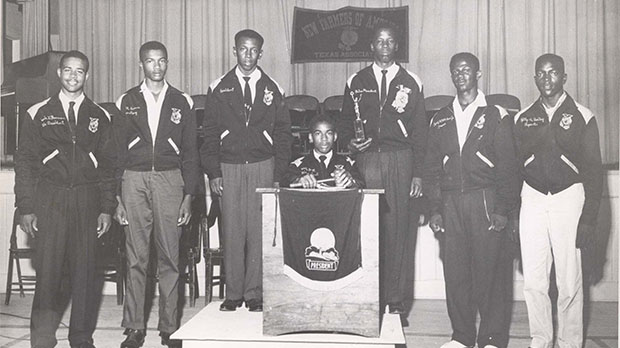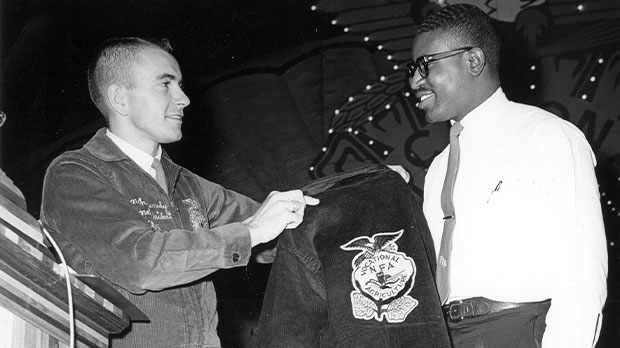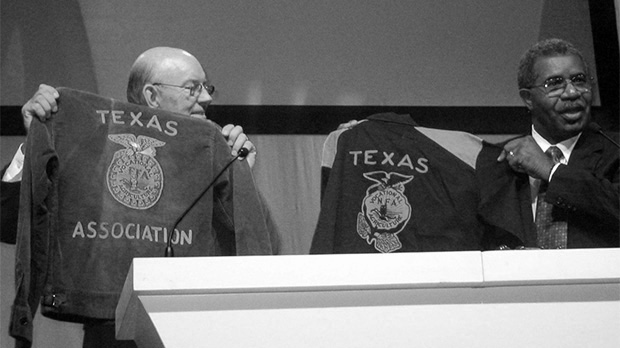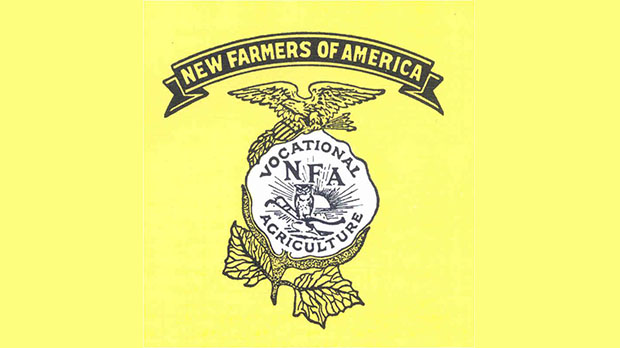|
|
| |
Past NFA, FFA Members Reflect on Merger 50 Years Later
Sunday, February 15, 2015 | Author: Leighton James, Texas FFA News Staff
Turn the clock back 50 years to 1965. Lyndon B. Johnson was president, the Beatles were at the top of the charts and America was in the midst of the Vietnam War. 1965 was also the dawn of a new age for FFA, because the New Farmers of America, an African-American organization for farm youth, and the FFA merged into one organization.
The New Farmers of America was a national organization formed in 1935 to serve African-American agricultural student in areas with segregated schools. The purpose of the NFA was to develop agricultural leadership and interest in farming occupations.

“The main thing was to develop a whole individual,” Alvin Larke, Ph.D. and retired professor from Texas A&M University said.
Although the merger in 1965 came and went long before current FFA members were even born, there are some individuals who remember how it impacted their lives.
“I was the last South Carolina [NFA] secretary,” said Larke. “We went to Atlanta in October 1965 and that’s when the merger took place.”

The national merger of the organizations at the 1965 National FFA Convention rose out of the 1964 Civil Rights Act. The NFA brought 50,000 members and 30 years of history.
“It has some emotional ties with it,” said Larke. “I was being groomed to become a national officer in the NFA, but I never reached that point because we merged that year. It took some time before African-Americans were placed in those positions.”
Horace Hodge, a member of the FFA from 1969 to 1973, was the first and, currently, the only African-American FFA chapter president at his high school.
“The year that I ran for office, I actually ran for the reporter position,” said Hodge. “I felt like the FFA had had quite a bit of influence on my life and I wanted the community to know more about it.”
However, his FFA chapter had different plans for him.
“When they brought us back into the room, they told me I was going to be president and I was totally shocked,” said Hodge.
Because of his ag teacher and his FFA experiences, Hodge attended Prairie View A&M to pursue a career in agriculture. He continued his FFA career in college as the Collegiate FFA president for two years.
“Other than my church and the influence of my parents, the FFA is the next entity that had the most influence on who I am and where I am and what I do today,” said Hodge.

Hodge also serves on the Texas FFA Board of Directors. In this position, Hodge has had the opportunity to see the organization grow, but also change in a variety of ways.
“In terms of FFA as an organization and what it offers, the opportunities are greater now, because LDEs and CDEs afford students a wider field of participation within the FFA,” said Hodge.
Although there has been growth in terms of opportunities, Hodge sees decline in other areas. According to the National FFA website, “the shortage of qualified agricultural science teachers is the greatest challenge facing FFA and agricultural education.”
This challenge is heightened when it comes to African-American agricultural science teachers. To help combat the current teacher shortage, institutions such as Prairie View A&M, are reengaging as a teacher training centers and becoming a more active proponent for the 21st century agriculture education model.
The current National FFA membership is 67 percent white, 22 percent Hispanic, 8 percent African American or American Indian and 3 percent Asian, Pacific Islander or two or more races.
Larke also pointed out the room for diversity growth in the FFA. Although his FFA career is over, Larke is still an advocate and supporter of the program. In his personal life, he tries to motivate students and specifically, minority students, to enroll in the FFA.
“The main thing we can do is encourage African Americans to enroll in agricultural education programs,” said Larke.
Hodge suggested that getting minority students to FFA events could inspire them to become members. Hodge believes his daughter, the first African American female to receive her American FFA Degree, was greatly impacted by her first national convention.
“I think the energy that was in that room still burns within her to this day,” said Hodge.

|
|
|
|
|
|
|
|
|